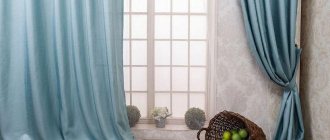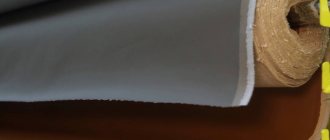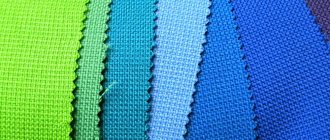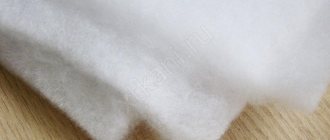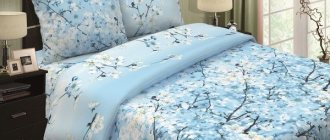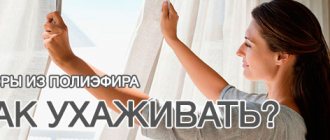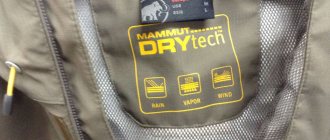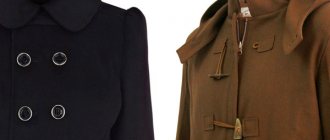Synthetic materials have become a part of our lives. The most common of them are polyamide and polyester, which are included in most purchased clothing. Our appearance and comfort depend on their properties. Let's try to figure out which is better, polyamide or polyester. They cannot be compared with natural and artificial fibers; the strength properties of synthetic materials are much higher.
Types of fabrics
Materials of different properties and qualities are produced in their pure form and with additives. The range of applications is very wide:
- cotton blend underwear;
- warm underwear made from a mixture of natural wool;
- knitted fabric for sportswear;
- a varied range of fabrics from evening silks to summer chiffons;
- voluminous coat fabric with the addition of synthetics is not afraid of weather conditions, is easy to care for and lasts a long time.
Mixed with other fibers and in pure form, synthetics serve modern people well in bad weather conditions.
Appearance and main characteristics
When wearing clothes or swimsuits made from this material, no marks remain on the skin. Polyester does not fade and does not leave an unpleasant odor after wear. Such clothes are comfortable for a person to play sports in. Polyester does not prevent the skin from breathing air and absorbs sweat that forms during physical activity.
Down jacket filling can be made from this material. It is able to retain heat well.
Jacket
Important! This material does not lose its shape when worn. However, this property manifests itself at temperatures not exceeding +40 degrees. This property is important when washing. It is not allowed to use hot water. However, whether cold or warm, this material can be washed efficiently.
This fabric is used to make not only clothes, but also bed linen.
Polyester Density Unit
Den is used to measure this value. It represents the quantitative relationship between mass and length. 1 Den corresponds to the fact that one gram of matter corresponds to 9 kilometers of thread.
This material does not stretch
Does polyester stretch or not?
Some characteristics cannot be perceived as clearly positive or negative. For example, the density of the fabric can slightly hinder movement, but on the other hand, it helps the clothing maintain its shape and prevents the material from wearing out.
You might be interested in Description of lycra: what kind of fabric is it, what material is it made from?
Polyester 90 elastane 10, what kind of fabric is it - it is durable, wear-resistant and elastic.
For your information! By adding viscose, a fabric is obtained that has the property of elasticity. As a result of heating, the shape of the fabric can be changed. In some cases this may be convenient. However, at normal temperatures the fabric will not stretch.
Polyester and elastane, what kind of fabric is it - it is thin and elastic and allows air to pass through well.
Shopping bags
Advantages and disadvantages
By changing its performance properties, synthetics improve the appearance of natural fabrics. With its addition, knitwear does not stretch, and cotton and wool do not wrinkle. The main thing is that its percentage does not exceed 30%.
Comparing polyester and polyamide, which is better for the economy, the first fiber is not only cheaper in primary production. Some of it is produced by recycling waste plastic. This type of production is less harmful to the environment.
Among the few disadvantages: the electrification of things; dense fabrics do not conduct air well, not suitable for hot weather; with a high content, the material is rigid.
Pural - reliable, strong, durable
Pural coating is made on the basis of polyurethane; the composition may contain polyamide and acrylic. The thickness of this durable protective layer is 50 microns, so it is very difficult to damage. Advantages of zinc-polyurethane coating:
- It is resistant to a certain number of chemically active substances, which allows the use of such products in areas with high levels of industrial pollution. Can be used in the construction of facilities in regions with a maritime climate.
- Fairly high resistance to ultraviolet rays, but over time the color brightness decreases.
- Withstands significant temperature changes, therefore it is used in harsh climatic conditions.
- The working period of such a tread layer is approximately half a century.
The disadvantage of pural coating is its high cost, several times higher than the cost of products with polyester protection. Most often used for roofing and finishing facades of luxury buildings. It is practically not used for constructing fences and utility rooms.
Attention! The matte pural coating has a special structure that provides additional protection against dirt.
Types of polyamide materials
The textile industry uses fiber to mix with natural fibers - wool and cotton, to produce products beloved by girls, such as nylon tights. Considering polyamide and polyester, which is better for outer sportswear, the plastic derivative will be out of competition. Nylon and nylon are obtained from 100% polyamide. Down jackets with such coatings are the best in their range. Nylon windbreakers are used with pleasure by athletes; they are lightweight and windproof; they are included in sports kits from well-known companies. Nylon is a weightless transparent fabric, it is the only one with such properties, and is used in elegant clothing.
Features of polyamide
Polyamide is a material of synthetic origin, quite popular in modern industry due to its qualities. This fiber is often added during the production of various fabrics used for sewing certain clothes. In most cases, this fiber has a somewhat rough surface , but recently fabrics with a smooth or glossy texture have become increasingly widespread.
The composition of polyamide, as the name implies, includes substances of the amide group . It is made by processing plastic obtained by using organic substances such as oil, coal or natural gas. The most popular fabrics include nylon, as well as nylon and perlon fiber.
Thanks to production technology and the use of certain components, polyamide has qualities that are highly sought after in the textile industry:
- It allows air to pass freely, thereby allowing the skin to “breathe”.
- It has a fairly high degree of strength.
- Doesn't wrinkle.
- Dries quite quickly.
- Retains its original external characteristics for a long time.
- Does not ignite.
- It is one of the fairly hygienic materials.
- It has a texture that is pleasant to the touch.
- Easily cleaned from various contaminants.
However, this raw material also has certain disadvantages:
- Polyamide has low heat-saving ability, so clothes made from such fabric are not suitable for cold weather.
- Also, due to its origin, the material has a high ability to accumulate static electricity.
- When washing items with this component, you cannot select a temperature above 30 degrees Celsius.
Advantages and disadvantages
It is lightweight and durable; these properties are transferred to natural materials in the mixture. 10% polyamide is enough to increase the wear resistance of cotton and wool by 2-3 times. The material is fusible, resists high temperatures, and after cooling retains the shape achieved when hot.
What is better, polyester or polyamide, you evaluate when you use a specific product. Each of the fibers considered is distinguished by its positive properties. Affordable polyester improves properties without increasing the cost of the material. Polyamide in a small percentage greatly changes the properties of natural materials in the underwear range, and hosiery products adorn the legs of modern girls.
Sewing master classes at the school “I Want to Sew”
Polyester production technology
About half of textile products use polyester. When trying to understand what kind of material polyester is, some believe that fabrics made from artificial fibers are uncomfortable and have a bad effect on health. Regarding polyester, such assumptions have no basis. This fabric looks beautiful, is comfortable to wear and completely safe for health.
Polyester samples
Fabric composition polyester
This fabric is made from petroleum products - polyesters. To produce polyester, you need to do the following:
- From oil it is necessary to isolate the chemical components from which polystyrene should be produced.
- After receiving it, it is necessary to carry out chemical and mechanical cleaning.
- The required chemical fibers are made from the resulting product.
- Preparation and finishing of threads are carried out.
- Fabric is produced.
Polyester ties
Although polyester is made from artificial threads, its physical properties are nevertheless similar to cotton fabric. Judging by its appearance, it resembles wool.
Cover
Made from 100% polyester
Dozens of varieties of popular fabrics for outerwear are created from polyester with a variety of textures and effects: with a matte or glossy surface, with a “chameleon” effect, as well as different tactile sensations: soft, smooth, dense, thin. This depends on the shape, weave and size of the primary fibers. Compounds with cotton, polyamide, acrylic, and lycra are widely used.
Such “different” fabric can be made from 100% polyester fiber: matte, shiny and brightly colored, as well as downright glossy.
A large group of hi-tec (high-tech) fabrics contains polyester fibers in varying quantities, and such fabrics, thanks to the latest expensive technologies and “intricacies” of fibers, have maximum protective properties and at the same time maintain good air exchange at the level of natural fabrics, i.e. .e. "breathe". Due to their complex production technology, high-quality polyester fabrics can be very expensive and exceed the cost of expensive natural fabrics (wool, silk).
Outerwear with the addition of polyester: jackets, coats, raincoats, windbreakers, down jackets are lightweight and durable, retain their shape perfectly, do not wrinkle, and do not let water through. The fabric repels dirt well, is resistant to light and heat, easy to care for, easy to clean and wash, and dries quickly. Such clothes will not lose their brightness, will not fade in the light and sun, and will not fade when washed.
| The fabric is made of polyester with the addition of cotton and metal. threads are a completely different “game” of color and texture. | The combination of polyester and silk provides a distinctly beautiful shine and strength. | The textured fabric shimmers in the light thanks to the complex technology of weaving wool, silk and synthetic fibers. |
Synthetic insulation materials, such as synthetic winterizer and holofiber, are based on polyester fiber.
Advantages and disadvantages
The positive properties of this fabric include the following:
- Polyester is characterized by high strength and is practically impervious to wear.
- Although the fabric is elastic, it does not stretch when worn. This property is similar to nylon.
- Polyester washes well. This can be done in cold water. At the same time, dirt is washed off well. The fabric can dry quickly.
- It has high consumer qualities. The fabric protects well from the cold and practically does not get wet. This is one of the reasons why polyester is used for outerwear. Having put it on, a person can be sure that it will protect him from bad weather - rain, snow or wind.
- This material is convenient for the production of clothing - it is easy to cut and use for sewing.
- The fabric is pleasant to wear and differs in that it creates a pleasant, light cooling effect.
- Clothes made from it look beautiful.
- Proper care ensures that clothes do not stretch or lose their color.
- Products made from this fabric do not attract insects.
- Clothes do not absorb odors, and greasy stains are easily washed off.
You might be interested in Description of eco-leather: natural or artificial material
The low cost of polyester, along with its advantages, contributes to the wide popularity of this material. Although polyester is similar to cotton in some respects, it is superior to cotton in many respects.
Oxford cloth made of polyester and nylon
Along with the advantages, this fabric has several important disadvantages:
- It is easily electrified. Because of this, dust is attracted and the matter sticks to the skin. This problem can be dealt with by using an antistatic agent or using a special conditioner during washing.
- If the polyester fiber is pure polyester, it feels hard to the touch and can chafe the skin. However, if it contains elastane or cotton, it becomes quite soft.
- If the weather is very hot, thick fabric feels uncomfortable to wear.
- Sometimes difficult to remove stains form on the fabric. In most cases they wash off easily. However, if such stains are present, it must be taken into account that their removal using special means may affect the color of the polyester in this place.
- Unfortunately, clothing made from this material is not hypoallergenic. A situation is possible when it will cause a corresponding reaction in a person. This probability increases depending on the differences between types of fabric.
- This fabric is considered a fire hazard. If placed near an open flame, it can easily catch fire.
Despite the presence of certain disadvantages, polyester is a high-quality and widely used fabric.
Curtains

